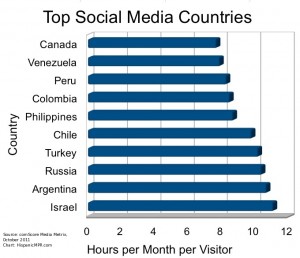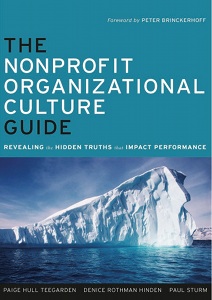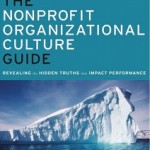Posted by Elena del Valle on January 9, 2012

Top Social Media Countries – click to enlarge
In many countries social networking has become ubiquitous. The mode of communication has become an essential part of people’s daily lives. Traversing international boundaries social networking has turned into the most popular online activity, according to It’s A Social World Top 10 Need-to-Knows About Social Networking and Where It’s Headed, a December 2011 comScore report. ComScore tracks online behavior and usage.
In October 2011, comScore researchers estimate social networking accounted for 19 percent of people’s time online or nearly 1 in every 5 minutes spent online; and social media, they believe, reaches 82 percent of the world’s 1.2 billion internet population.
Where people used to send emails and use instant messaging software to communicate many now rely on social media, the report says. In the United States (98 percent) and Canada (94 percent) social media site penetration, comScore staff believe, is nearly pervasive. They also estimate 41 of the 43 markets individually reported by comScore exhibit a market penetration of 85 percent or more.
When the researchers examined total time spent online, Israel was the most active country, followed by Argentina, Russia, Turkey, Chile, Philippines, Colombia, Peru, Venezuela and Canada. People in the Asia Pacific region, particularly East Asian countries, spend the least amount of time on social networks, according to the comScore findings.
The report also indicates women spend more time social networking than men. For example, women in North America and Europe, spent an average of nearly two hours (30 percent) more than men on social networking sites in a month. Older adults, users 55 and older, are the fastest growing segment in social networking sites, says the report.
Facebook is the undisputed leader in most countries. In October, Facebook reached 55 percent of the world’s audience, accounting for about three in every four minutes people spent on social networking sites and one in every seven minutes they spent online per comScore data.
Microblogging, mainly Twitter, is booming worldwide. Twitter reaches one in ten internet users around the planet to rank among the top social networks. In the last year it grew 59 percent. While initially users in the United States drove social media and microblogging growth that is no longer true. Only 19.8 percent of Facebook users, 20 percent of Twitter fans, and 38.2 percent of LinkedIn users are in the United States.
Posted by Elena del Valle on January 6, 2012

The Nonprofit Organizational Culture Guide book cover
Photos: Josey-Bass, Greg Shaler, Paige Hull Teegarden, Paul Sturm
What people say and what they do are often in conflict and so it is with the organizations where they work and that they run. Companies and organizations, like people, may unwittingly send mixed messages. One organization may tout its democratic and equitable approach toward its members while exhibiting a clearly discriminating pattern of employment toward its staff, for example.
The often unwritten organizational culture sets the tone within an organization and dictates informally the direction it takes and its parameters. Each company or organization has its own unique culture. There is, according to some experts, no single culture that is the best for everyone. On the other hand, it is important when dealing with any organization or company to be aware of and understand its culture. And, for profit and nonprofit entities are different by their very nature.

Paige Hull Teegarden, M.P.P.
There are about two million nonprofit organizations employing as many as eleven million people in the country. Although many assumptions can be made about the characteristics of a nonprofit entity often there are no clear definitions about its organizational culture. In The Nonprofit Organizational Culture Guide Revealing the Hidden Truths that Impact Performance (Josey-Bass, $40), Paige Hull Teegarden, M.P.P., Denice Rothman Hinden, Ph.D., A.C.C., and Paul Sturm, M.P.A., M.S. outline their thoughts on the topic for an audience of nonprofit leaders, managers, educators, funders and anyone seeking to understand the nonprofit sector and its effectiveness. The book required seven years of work and two publishers (the first one went out of business before publishing the book) before becoming available in December 2010.
The authors believe understanding the culture of an organization is an ongoing process that may assist those who work in or interact with the organization to be effective in orienting new staff and board members, identify leaders, define the organization’s change parameters, develop matching strategies, communicate and market with success, and find appropriate restructuring or merger choices.
“There were three big challenges. One was our inability to get financial support early on to support our research. Folks just weren’t convinced that we could reveal something that you can’t see. The second challenge was losing our publisher just before the book was going into production. The third challenge was keeping up the energy of all three authors to get the book out after seven years of trials,” said Rothman Hinden in response to a question about the biggest challenges they faced.
“Building upon the previous research and literature about organizational culture in a way that would be useful to nonprofit organizations. Prior to our book, virtually all the work and references about organizational culture had been focused on for-profit corporations,” said Sturm in response to the same question.

Denice Rothman Hinden, Ph.D., A.C.C.
The 174-page softcover book is divided into five chapters: Nonprofit Culture, Six Examples of Nonprofit Culture in Action, Revealing Organizational Culture, Reflections on Organizational Culture, and Recommendations for Nonprofit Leaders and Capacity Builders; and three appendices: Sector Informants, Organizational Culture Diagnostic Tools and About Mind Maps and Mind Mapping.
The authors propose four phases toward revealing the organizational culture process: Preparing by establishing a basic understanding of the organization and its context; identifying the organization’s objectives by finding culture stories and understanding their meaning; studying how the organization’s culture may affect the organization in achieving its objectives and developing a plan of action; and examining the ways in which change takes place within the organization in order to implement a plan.
“The encouragement and feedback we’ve received from thought-leaders and others committed to enhancing the effectiveness of nonprofit organizations and the nonprofit sector,” said Sturm when asked about the most rewarding aspect of collaborating in the book.
“Most rewarding has been demonstrating to organization leaders that there is great value in paying attention to what you can’t easily see in organizations. The book is a call to action to leaders to think about organizational experiences in a different way, and to use what they learn to create more effective management and program strategies. Helping nonprofit organization leaders think intentionally about the hidden elements of organizational culture is an important new step for strengthening organization performance,” said Rothman Hinden.

Paul Sturm, M.P.A., M.S.
Hull Teegarden, president, Think Outside, is a systems thinker with more than 15 years of experience. Rothman Hinden*, president, Managance Consulting & Coaching, has more than 25 years of nonprofit management experience. Sturm, a 25-year specialist in nonprofit leadership development and capacity building, teaches at the University of Baltimore and the College of Notre Dame of Maryland.
* The author of this note and Denice Rothman Hinden have been friends for many years.

Click to buy The Nonprofit Organizational Culture Guide
Comments:
Filed Under: Books
Posted by Elena del Valle on January 4, 2012

Photo: Hulu Latino
Hulu, an online portal offering ad supported video content from NBC, Fox, ABC, CBS, and Nickelodeon among others, decided recently to target Spanish speakers in the United States with a new channel, Hulu Latino (hulu.com/latino). Content for the new portal, only available domestically, is provided and selected by eleven companies: Azteca America, Butaca, Caracol Televisión, Comarex, Estrella TV, Imagina US, Laguna Productions, Maya Entertainment, RCTV, Todobebe Inc, and Venevision.
Hulu staff hope to capture the under served market segments of the video watching Hispanic market. They believe that, based on Nielsen data, 78 percent of that segment is bilingual. A spokesperson explained by email that promotion of the new channel will be the responsibility of its content partners. She declined to identify Hulu audience numbers, the exact target audience for the new portal or the exact number of Spanish language videos on offer.
She responded by email saying “The portal launched with hundreds of hours of Spanish-language film and TV shows on Hulu and Hulu Plus;” and “Hulu does not break out specific viewership information, but what we can say is that we are very excited about the new audiences we expect to serve with this content.”
According to an article in the Los Angeles Times (Hulu launches Latino service with Spanish-language programming) December 13, 2011 there are five Hulu Latino sponsors, Corona, Modelo, Toyota, Pantene, and Volkswagen of America.
NBCUniversal (Comcast/General Electric), News Corporation, The Walt Disney Company and Providence Equity Partners (owner of Newport Television) own Hulu. Founded in March 2007, Hulu has offices in Los Angeles, New York, Chicago, Seattle, Tokyo and Beijing.
Posted by Elena del Valle on January 3, 2012

As we start another year we are thankful for the years passed and for you our readers and listeners of the HispanicMPR articles and podcast interviews.
We wish you a very healthy, happy and prosperous New Year!

















